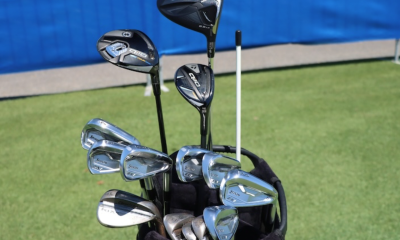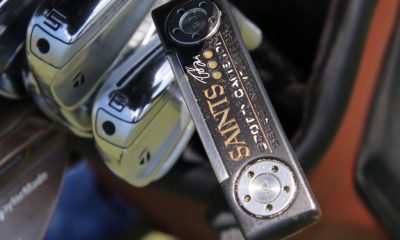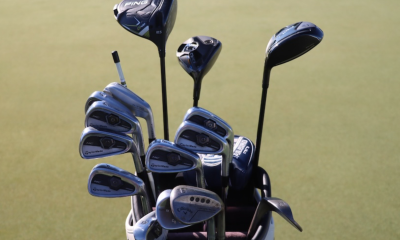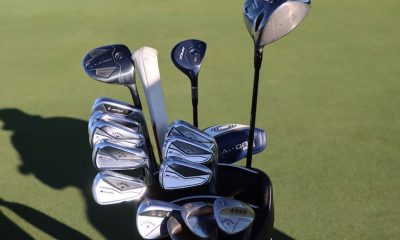Instruction
10 rules for sticking your irons

By Johnny Miller
A Golf Digest Article
With Guy Yocom
Photo By Joey Terrill
01 Play more than you practice.
Shortly after I turned 14, in 1961, I became the first junior member (whose father was not a member) at the Olympic Club in San Francisco. Playing Olympic day in and day out made me the good iron player I turned out to be. You never seem to get a level lie at Olympic. You’re required to hit a lot of awkward shots, such as playing a fade with the ball above your feet. You can’t work on shots like that on the practice tee, which is why I always played more than I practiced. A lot of things I learned on Olympic defied conventional teaching. For example, from a sidehill lie with the ball below you, the tendency is to pull it dead left—not slice it, as most instructors say—because you straighten your right arm to reach the ball, and you swing over the top. Don’t be one of those driving-range superstars: players who can make their irons sing on the practice tee but are only so-so on the course. Get out and play.
02 Don’t fall in love on demo day.
In 1974, I got a set of old Tommy Armour irons with no chrome on them. These dull-gray clubs had a soft feel to them that was just exquisite. The irons were 25 years old, but after I sawed down the hosels and added some lead tape here and there, they were like magic. I got on the hottest streak of my career. I won eight times on the PGA Tour in 1974, knocking down flags every week. The following year I signed an equipment contract and had to put the Tommy Armours in the garage. Big mistake. No matter what I did, I couldn’t make the new clubs perform like the old ones. If you’ve got a set of irons you really like, think twice before switching to a new set. There are a lot of great new irons out there, and you might fall in love with how well you hit them on demo day. But when you get on the course and face funny lies and try to hit shots, like a high draw or a low fade, you might find they’re completely different.
03 Listen to your shots.
In the winters when I was a kid, my dad had me practice in the basement of our house. I’d hit balls for hours into a canvas tarp tacked to the ceiling. Because I couldn’t see the ball flight, I relied on two kinds of feedback: how the shots felt and how they sounded. Thin shots, balls struck on the toe, and shots hit a shade fat have distinctive sounds. You’re always looking for that crisp thwack at impact. Even from the TV booth, I can usually tell immediately if an iron shot is mis-hit and if it will come up short or not have enough spin to hold. Sound can definitely give you clues as to how well you hit the shot.
04 Distance trumps direction.
If you’ve ever wondered what magic threshold you must cross to become a first-rate player, it’s simple: You must control distance with your irons. I’ve always been obsessed with distance control. When I felt my iron game was at its peak, I’d sometimes ask my caddie for the distance to half a yard. You control distance by hitting the ball solidly and varying the length and speed of your swing. If you do that well, you become more precise, which rubs off on your direction, too. The week I won the 1974 Tucson Open, I hit hole or the flagstick 10 times.
05 Get down on it at impact.
I’m a swing-sequence junkie. I love poring over sequence photos of the best players. The feature all great iron players have in common is that their heads are lower at impact than when they were standing tall at address. They really go down after the ball, not by bending at the hips or dropping their head but by increasing the flex in their knees. They sag their knees down and toward the target at the same time, moving on a downward diagonal line. Now, you’d think this would make you hit the ball fat. But if you lean the club forward, toward the target, so that the shaft is angled ahead of the left arm, you’ll absolutely pure it. Which leads to the next rule.
06 Keep the angle in your right wrist.
Through impact, the hands lead a trailing clubhead. That delofts the clubface and makes it possible to hit down on the ball and squash it against the face. If you’ve ever wondered how good iron players make their shots bore through the air, this is it. Every effective iron player maintains the semi-cocked position in the right wrist through impact, the right palm facing down. Every bad ball-striker has the palm up. As I said only half-jokingly on a telecast last summer, if you want to be a terrible iron player and avoid getting to single digits, just flip that right wrist so the clubhead scoops and passes your hands.
07 Don’t sweat every detail.
Because iron play is all about precision, there’s a tendency to focus on details that are irrelevant or uncontrollable. For instance, a slightly wet clubface won’t affect distance. And you can’t predict how a small glob of mud on your ball will influence ball flight, so don’t stress about it. A light breeze won’t affect distance much if you hit the ball solidly. Concentrate on things that matter: alignment, rhythm and solid contact. Perform those well, and the small things won’t really come into play.
08 “Photograph” impact.
During one of my nice streaks in the mid- 1970s, Jack Nicklaus stopped me on the range one day and asked what I was working on. I told him I was concentrating on impact, trying to “freeze frame” that fraction of a second. “You can actually see that?” asked Jack. When I told him I could after months of training my eyes to take a “photograph” of impact, Jack said, “You’re crazy; the club is moving too fast.” But, as I said to him, it’s not only possible, it’s one of my secrets for hitting great iron shots. When I took the picture, so to speak, I checked that the clubface was square and delofted slightly, and that I was making crisp contact. Satisfy those impact conditions, and you’ll start chasing flags.
09 Identify the sweet spot on your irons.
I’ll bet that if you asked the typical 15-handicapper to point to the sweet spot, he’d point to a spot too high on the face. Remember, all perimeter-weighted irons have the majority of their mass around the sole of the club, to help you get the ball in the air. That means the sweet spot is below the center of the face. This really comes into play on par 3s, where you’re allowed to tee up. Your objective should be to tee the ball so your “lie” is slightly better than a perfect fairway lie. And even with perimeter weighting, because of the design of the clubhead, the sweet spot is going to be slightly closer to the hosel than the toe.
10 Speed kills.
I can see wanting 10 more yards with the driver, but squeezing extra distance out of your irons is the kiss of death. In my prime, my standard distance for the 9-iron was 125 yards. I hit my 6-iron 160, and my 4-iron 185. I didn’t want to be long with my irons, only smooth. Reining in my swing speed was key to distance control and accuracy. If you can resist the tendency to swing more than 75 percent, you’ll have better balance and rhythm. Your mechanics will be better, and you’ll find the sweet spot more often. You don’t need a crazy swing speed to spin the ball, either: Pure backspin comes from good contact more than anything else.
Read More http://www.golfdigest.com/magazine/2009-01/millerrules#ixzz1fd6UL9UZ
- LIKE7
- LEGIT0
- WOW0
- LOL0
- IDHT0
- FLOP0
- OB0
- SHANK0
Instruction
Clement: Laid-off or perfect fade? Across-the-line or perfect draw?

Some call the image on the left laid off, but if you are hitting a fade, this could be a perfect backswing for it! Same for across the line for a draw! Stop racking your brain with perceived mistakes and simply match backswing to shot shape!
- LIKE0
- LEGIT0
- WOW0
- LOL0
- IDHT0
- FLOP0
- OB0
- SHANK1
Instruction
The Wedge Guy: The easiest-to-learn golf basic

My golf learning began with this simple fact – if you don’t have a fundamentally sound hold on the golf club, it is practically impossible for your body to execute a fundamentally sound golf swing. I’m still a big believer that the golf swing is much easier to execute if you begin with the proper hold on the club.
As you might imagine, I come into contact with hundreds of golfers of all skill levels. And it is very rare to see a good player with a bad hold on the golf club. There are some exceptions, for sure, but they are very few and very far between, and they typically have beat so many balls with their poor grip that they’ve found a way to work around it.
The reality of biophysics is that the body moves only in certain ways – and the particulars of the way you hold the golf club can totally prevent a sound swing motion that allows the club to release properly through the impact zone. The wonderful thing is that anyone can learn how to put a fundamentally sound hold on the golf club, and you can practice it anywhere your hands are not otherwise engaged, like watching TV or just sitting and relaxing.
Whether you prefer an overlap, interlock or full-finger (not baseball!) grip on the club, the same fundamentals apply. Here are the major grip faults I see most often, in the order of the frequency:
Mis-aligned hands
By this I mean that the palms of the two hands are not parallel to each other. Too many golfers have a weak left hand and strong right, or vice versa. The easiest way to learn how to hold the club with your palms aligned properly is to grip a plain wooden ruler or yardstick. It forces the hands to align properly and shows you how that feels. If you grip and re-grip a yardstick several times, then grip a club, you’ll see that the learning curve is almost immediate.
The position of the grip in the upper/left hand
I also observe many golfers who have the butt of the grip too far into the heel pad of the upper hand (the left hand for right-handed players). It’s amazing how much easier it is to release the club through the ball if even 1/4-1/2″ of the butt is beyond the left heel pad. Try this yourself to see what I mean. Swing the club freely with just your left hand and notice the difference in its release from when you hold it at the end of the grip, versus gripping down even a half inch.
To help you really understand how this works, go to the range and hit shots with your five-iron gripped down a full inch to make the club the same length as your seven-iron. You will probably see an amazing shot shape difference, and likely not see as much distance loss as you would expect.
Too much lower (right) hand on the club
It seems like almost all golfers of 8-10 handicap or higher have the club too far into the palm of the lower hand, because that feels “good” if you are trying to control the path of the clubhead to the ball. But the golf swing is not an effort to hit at the ball – it is a swing of the club. The proper hold on the club has the grip underneath the pad at the base of the fingers. This will likely feel “weak” to you — like you cannot control the club like that. EXACTLY. You should not be trying to control the club with your lower/master hand.
Gripping too tightly
Nearly all golfers hold the club too tightly, which tenses up the forearms and prevents a proper release of the club through impact. In order for the club to move back and through properly, you must feel that the club is controlled by the last three fingers of the upper hand, and the middle two fingers of the lower hand. If you engage your thumbs and forefingers in “holding” the club, the result will almost always be a grip that is too tight. Try this for yourself. Hold the club in your upper hand only, and squeeze firmly with just the last three fingers, with the forefinger and thumb off the club entirely. You have good control, but your forearms are not tense. Then begin to squeeze down with your thumb and forefinger and observe the tensing of the entire forearm. This is the way we are made, so the key to preventing tenseness in the arms is to hold the club very lightly with the “pinchers” — the thumbs and forefingers.
So, those are what I believe are the four fundamentals of a good grip. Anyone can learn them in their home or office very quickly. There is no easier way to improve your ball striking consistency and add distance than giving more attention to the way you hold the golf club.
More from the Wedge Guy
- The Wedge Guy: Golf mastery begins with your wedge game
- The Wedge Guy: Why golf is 20 times harder than brain surgery
- The Wedge Guy: Musings on the golf ball rollback
- LIKE86
- LEGIT13
- WOW6
- LOL1
- IDHT0
- FLOP4
- OB1
- SHANK8
Instruction
Clement: Stop ripping off your swing with this drill!

Not the dreaded headcover under the armpit drill! As if your body is defective and can’t function by itself! Have you seen how incredible the human machine is with all the incredible feats of agility all kinds of athletes are accomplishing? You think your body is so defective (the good Lord is laughing his head off at you) that it needs a headcover tucked under the armpit so you can swing like T-Rex?
- LIKE0
- LEGIT2
- WOW2
- LOL0
- IDHT0
- FLOP0
- OB0
- SHANK2
-

 19th Hole2 weeks ago
19th Hole2 weeks agoDave Portnoy places monstrous outright bet for the 2024 Masters
-

 19th Hole3 days ago
19th Hole3 days agoJustin Thomas on the equipment choice of Scottie Scheffler that he thinks is ‘weird’
-

 19th Hole2 weeks ago
19th Hole2 weeks agoTiger Woods arrives at 2024 Masters equipped with a putter that may surprise you
-

 19th Hole3 days ago
19th Hole3 days ago‘Absolutely crazy’ – Major champ lays into Patrick Cantlay over his decision on final hole of RBC Heritage
-

 19th Hole2 weeks ago
19th Hole2 weeks agoTwo star names reportedly blanked Jon Rahm all week at the Masters
-

 19th Hole1 week ago
19th Hole1 week agoReport: LIV Golf identifies latest star name they hope to sign to breakaway tour
-

 19th Hole1 week ago
19th Hole1 week agoNeal Shipley presser ends in awkward fashion after reporter claims Tiger handed him note on 8th fairway
-

 19th Hole1 week ago
19th Hole1 week agoBrandel Chamblee has ‘no doubt’ who started the McIlroy/LIV rumor and why
















rehcuagflog
Dec 28, 2011 at 11:39 am
I apologize for my english writing, I’m a french speaker so…. Simpicity, balance teaching, kind of ABC you should work all day long… like blopar, we need more this kind of inside, particulary Golfdigest need to reconsider the serious of some articles, like who is the hottest golfer…? who care…
MK
Dec 19, 2011 at 7:03 am
Fantastic tips, gives me something to think about when I go out this week.
blopar
Dec 13, 2011 at 12:06 pm
there is more great advice packed in these 10 tips than there is in a years’ worth of golf digest, golf, and golf tips combined
Mizunate!
Dec 5, 2011 at 4:52 pm
Invaluable tips from a true legend. Thanks!